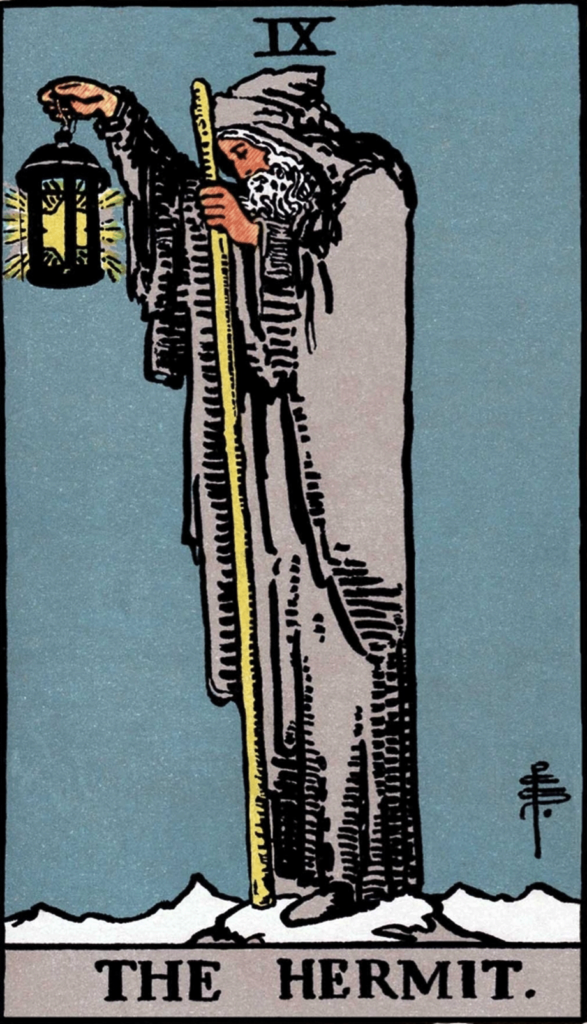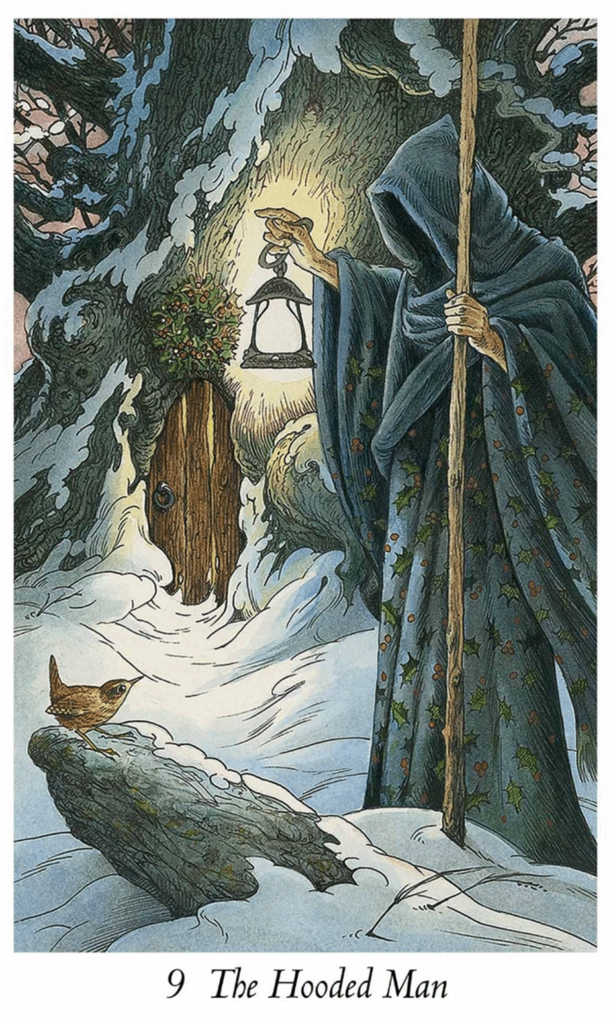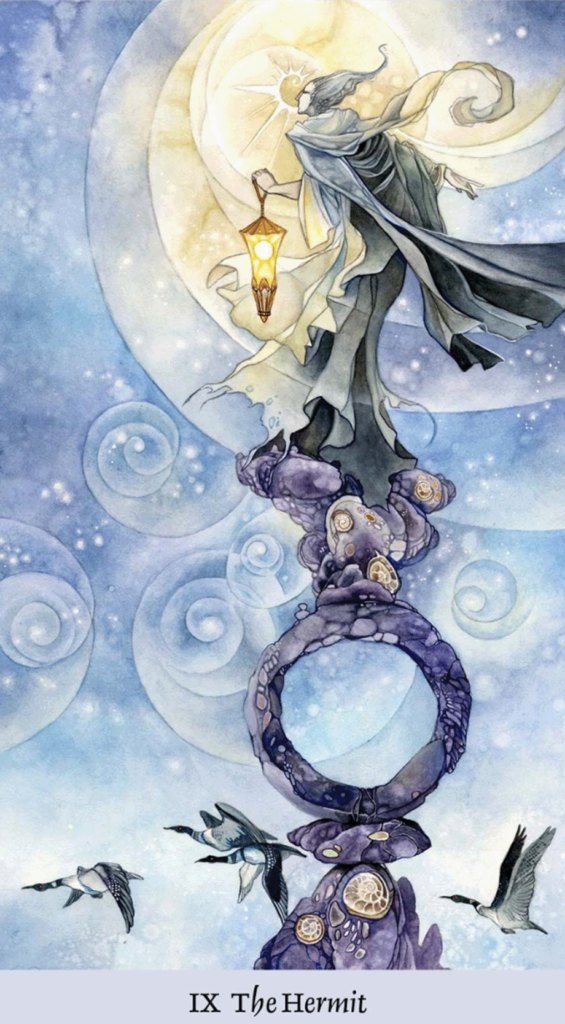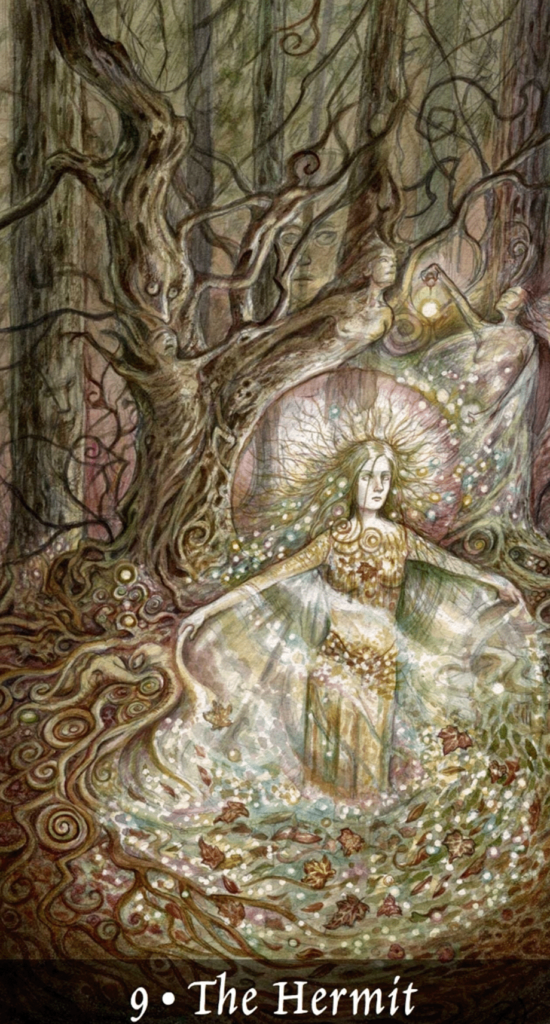Card IX of the Major Arcana is one that I find myself drawn more and more to as I get older. This is, to my thinking, something of a natural progression, and we’ll look into that. For those who have not read my earlier articles where the Hermit is discussed in various contexts, this will likely all be new territory. For those who have followed me for a while, I trust you will forgive any repetition of concepts mentioned in those earlier articles as we delve into this week’s topic.
The Hermit card shows a lone figure standing on a snowy mountain summit against a blue sky. He wears a hooded grey robe, and has long white hair and beard. In his left hand he holds a simple staff, and in his right he holds a lantern. In the midst of the lantern is a hexagram star, giving off rays that travel only a short distance. There are the tops of other mountains seen in the distance. His gaze is cast downward.

The design here is one of the simplest of all the Major Arcana. That is appropriately in keeping with the subject as an ascetic engaged in isolated contemplation. Because, as we have discussed, Waite’s charge for this deck was intimately connected with Christianity, the figure is portrayed more or less as a lone monk.
Monasticism in origin was not the movement that it later became. The practice began with individuals withdrawing from the word and living completely alone, often in caves in the desert. There were no orders, and there certainly were no monasteries. The “mon” in monastic, and indeed in monk, is derived from monos- one, or lone. Supposedly Benedict was the first of these early monks to put forth the idea that they could all be alone together, and thus formed a monastic order. Later such orders would be approved as official by the church, and charged with specific duties and obligations. I imagine similar developments occurred within Buddhism, but there are still hermit monks in many traditions, who seek personal wisdom and enlightenment by a quiet withdrawing from the world.
This context is central to a number of the meanings and associations ascribed to this card. In a Christian scenario, the withdrawal is to place oneself away from sin, or at least, from the temptation to sin. In this way the Hermit purifies himself from the flesh, and thereby encourages the spirit. The wisdom imparted here, of course, is the absolute truth and rightness of the Christian teaching, and thereby the hermit monk has his soul saved, while his body suffers.
Mortification is practiced in multiple cultures for purification, but also for the creation of trance states and the getting of visions. Living in a cave in isolation, subsisting on a diet of “locusts and wild honey” could certainly induce psychologically altered states of consciousness. If one is bent to be looking for signs from God, those altered states can take on the character of a profound religious experience. Ironically, of course, these experiences are frequently depicted as ecstasy, general of the physical kind that the hermit has moved out into the wilderness to avoid.
The Hermit is traditionally given the Sign of Virgo astrologically. I find this a rather simplistic reading, equating virginity to the avowed celibacy of the monk. The two are not identical, nor are they interchangeable. It’s simply convenient to make the attribution if you are looking for some place in the Tarot to attach Virgo. The fact is, as I have mentioned before, that the Hermit in earlier decks is a personification of passing Time, and this Chronos being confounded in ancient days with Kronos the Titan, makes Saturn a more apt connection than Virgo.

I have personally always seen the Hermit as analogous with both Father Time and some Saturnine aspect, and as I age, this is even more apparent. My own second Saturn return is now less than a year away, and astrologers suggest that this brings with it contemplation of deeper meanings, the path that we have taken, and the potentially shorter path that lies ahead. Old Saturn with his 29 year cycle, was rarely met more than twice by our ancestors, and sometimes no more than once. Thus associating him as I do with the aged figure on the mountain top, perhaps looking back along the trail he has climbed, is not so arbitrary as the monkish renunciation of carnal activities.
I personally identify greatly with the Hermit card. It is not that I am anti-social, at least in the sense that I live in a cave in the desert and eat bugs. But I have for more of my life than not, been very insular and private. My world has almost always been more of the inward one than the outer one. The cave I inhabit is internal. As a precocious and odd child, my social isolation was very common. I had few friends and most of them were similarly odd. I cannot with any accuracy say if the experience of being an outsider or loner led to my inclination toward silence and self-contemplation, or if I had a bent for quiet meditation that limited the ability of other more outgoing types to bond with me. Whether it was the chicken or the egg, the result is that I generally prefer pursuits of a personal nature rather than a collaborative one.
That is not to say that I am incapable of interacting with others, but it does require a great deal of energy and focus, even with persons whose company I enjoy sharing. This, I believe, is what they are defining as introversion these days. There is possibly also some overshadows of the autistic spectrum that may be applicable. The difficulty inherent in expressing oneself, combined with the discomfort, or even fear, of being misunderstood, and a compulsion to pre-run the outcomes of any and all scenarios, creates a synergy where communication is a complex and stress inducing task. The result is frequently exhausting, and therefore the appeal of the quite moments alone. The obligations of my life as I have lived it, and as the result of the choices I have made along it, require me to adapt and develop coping mechanisms to address these stresses. I have been doing so for the better part of half a century, but as I get older, I am becoming more selective as to when I need to employ those mechanisms, and when the outcome is equal or even better if I simply make the choice to be that Hermit.
Of course, my life would probably be much simpler if I had not self-imposed the need to author a weekly article on various subjects to an audience who may or may not be out there.
But that brings us to the Hermit’s Lantern.

I have one of those, you know. Found it at one of the discount stores that deal in leftover merchandise originally offered in the high-end department stores. I also have a staff and the monks cassock. Sometimes things just click like that.
But the Hermit’s lamp first and foremost is the analogue for the wisdom he has gained, the secrets that he has teased out of the dark bosom of the universe during the nigh endless hours of lonely seeking. Because, frankly, the point of wisdom is to pass it on. We are potentially alone on this planet in our ability to communicate our experiences to others in a fashion that expands and extends their value.
While there are a good many creatures that exhibit the ability to pass data instinctively, there are, at least as far as we know, none that can record that data in perpetuity. The monasteries of all faiths seem to affirm the need to chronicle what comes from contemplation, meditation, and isolation. They maintain libraries as a part of their function, and through that we have preserved the collected musings of the ages. It is a sad fact of history that many such libraries were lost to war, disaster, and accident, yet what remains, though meager, is wonderful.
The purpose of the Hermit is therefore not to leave this world, but to know it. This ties card IX to card 0, the Fool. As I stated early, the symbolism of the Fool is that state of Unknowing, that exists in the Unformed. It is that moment of Becoming, that is precipitation by the I withdrawing from the Not I , that is the creation of all. The edge of the cliff the Fool strides toward is where the Universe divides from itself in order to know itself. The death presaged by the card is real. The Universe as it was before will die, and never be again, because as the full plunges over the edge a new Universe begins that has the capacity to be experienced.

And here is the Hermit withdrawing from the world, to know himself, and in doing so, to know the greater truth that lies beyond that edge, to return, perhaps to the Unknowing, beyond that event horizon where the original Idea was made form. It is a parallel intention.
While the Fool simply does, and the result becomes the intention, the Hermit intends. I made a distinction earlier between virginity and celibacy. This is exemplified in the relationship between these two cards. Virginity is an initial state of the origin of things, that once lost, may never be again. Innocence cannot be regained. Celibacy or chastity is the result of an intended act of restraint that may be constant or practiced in intervals. While the two can exist together, that is, one can be virginal and also chaste, it is not necessarily required for the chaste to be a virgin.
Virginity is the condition of our beginning. The Fool is the first card. When we reach the Hermit, we are presented with an old man, who we hope is wiser, but is likely no longer innocent. He chooses to be apart from the world because he has known it. Yet this choice makes it all the more present in his mind.
Anyone who has gone on a diet has experienced the stronger craving for something they are forbidden, even though they were not so desirous of it when they could have it. This is what makes the changing of habits difficult.
The Buddhists say that this is why we can’t free ourselves from the desire to be, and return to the nothingness that is. We are no longer the Fool, the Unknowing, and while our objective as the Hermit is to deny it, that denial makes the desire for it even stronger. We can be as celibate as we want, but it doesn’t ever make us a virgin.
So faced with this contradiction, the Hermit re-enlists in the world, at least to the extent that those rays will reach. The light from the Hermit’s Lantern is dim, not because it does not burn brightly, but because, as a consequence of the experience only known to the Hermit, is incredibly difficult to communicate with others who lack his frame of reference.

This is why scholars and writers on esoterism and philosophy make a distinction between intelligence and wisdom. We can easily impart facts to one another. We can express that two and two are equal to four, and that four and four are equal to eight. We can explain how to properly conjugate verbs in all the languages of the human race. But when it comes to sharing our insights into the sublime wonders of the Divine our mouths fall silent. Our tongues are still. The words are simply not enough.
The Hermit’s Staff is his knowledge. He leans upon it. It is firm. It is strong. He can hand that Staff to another and it will be unchanged. It will be firm and strong and equally useful, but it is not the Light of the Lantern, with the shape barely visible within it, the simple, but also phenomenal “As above, so below”.
And as without, so within. He lives in the internal world, his eyes downcast. What does he see? What does he not see?
He may be looking toward the path he has climbed. He may be looking at the deepening road before him.
But one thing is certain. He does not, at least, look at the Lantern.
Is it because he has already seen the Light, or is it because the Light is too bright to bear. It stands out from him. It is separated from him, unlike the staff which he holds close to the body. Is this to make it a beacon unto others, or is it because he cannot stand it being too close, because the brightness is a pain and a distraction? Does it light his path, or does it obscure it to his aging gaze?
I can only say that walking along that path myself, there are times when the light is too dim to make anything out, and times when it is too bright to make anything out, and in the end both results are same. You have to put your next foot forward carefully, and hope for the best.
If you are lucky, you won’t step off that cliff.
Join me next week for Fortune’s Wheel and the inexorable turning of the days from spring toward summer. Thank you for your continued patronage.

